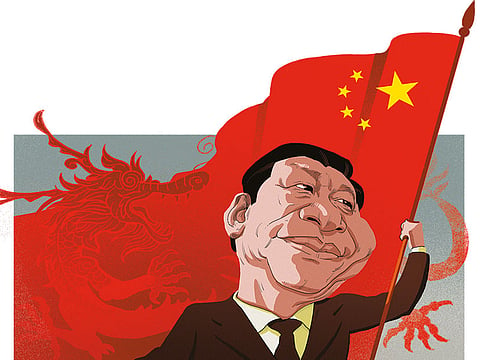China is all set to conquer the world
There’s an eerie sense that Beijing is racing to capture the commanding heights of global technology and trade

The friendly words exchanged between Presidents Donald Trump of the United States and Xi Jinping of China this month softened the edge of a Chinese economic and military build-up that a recent study commissioned by the Pentagon described as “perhaps the most ambitious grand strategy undertaken by a single nation-state in modern times”.
At the Beijing summit, Xi repeated his usual congenial injunction for “win-win cooperation” and Trump responded in kind, calling Xi “a very special man”. Trump also complained about the Chinese trade surplus, but the visit was mostly a serenade to Sino-American cooperation.
What caught my ear was Xi’s hint of China’s big ambitions in his toast that night. He quoted a Chinese proverb that “no distance, not even remote mountains and vast oceans, can ever prevent people with perseverance from reaching their destination”. Xi then cited an adage from Benjamin Franklin: “He who can have patience, can have what he will.” That’s an apt summary of China’s quiet, but relentless pursuit of becoming a global superpower.
China’s rise has been so rapid yet gentle in tone that it’s easy to miss how fast Beijing has expanded its ability to project power. The mesmerising go-slow style of the pre-Xi years, summarised in the Chinese slogan “hide and bide”, has been replaced by what US analysts now see as an open power play.
Trump’s “America first” strategy has facilitated China’s build-up, unintentionally. The administration’s rhetoric on fair trade has been strong, but the actual gains have been modest. Meanwhile, Trump has shredded the Trans-Pacific Partnership and stepped back from other US-led alliances — opening the way for China’s new network of global institutions, including the ‘One Belt, One Road’ (OBOR) plan for Eurasian trade and the Asian Infrastructure Investment Bank to finance Chinese-led projects.
The scope of China’s challenge to the America-led order is described in two unpublished and unclassified studies commissioned by the US Air Force. One study argues that China’s Eurasian reach is beyond that of the 1947 Marshall Plan, which cemented American power in post-war Europe. The report estimates that the OBOR framework would provide up to $1 trillion (Dh3.67 trillion) in Chinese support for more than 64 countries, while the Marshall Plan provided about $150 billion in current dollars, mostly to six countries. The report describes OBOR as “a programme of unprecedented size and scope with the strategic intent of constructing a Chinese-led regional order in Eurasia”.
China is building the infrastructure of power. The study describes, for example, how Beijing is financing a string of ports in the Indian Ocean region, including in Sri Lanka, Malaysia, Pakistan, Myanmar, Djibouti, Kenya and in the Middle East. The proposed investment is nearly $250 billion.
‘Strategic beachhead’
China has also invested $13.6 billion in Greece, buying control of the port of Piraeus and big shares of Greek utilities and fibre optics companies. “Greece serves as a strategic beachhead for China into Europe,” notes the report.
The Asian Infrastructure Bank, meanwhile, has approved $16 billion in projects in 10 countries, including long-standing US allies such as Egypt, India and Oman. And the Chinese are building rail lines to Europe and every part of Asia, allowing them to bypass US-controlled sea lanes. China already has 40 rail routes to nine European countries.
American dominance has been built partly on the primacy of its scientific and technological laboratories, which have drawn the best and brightest from around the world. But the Chinese are challenging here, too. China is building at least 50 joint-venture science and technology labs with OBOR countries and plans over the next five years to train up to 5,000 foreign scientists, engineers and managers, the study notes.
As foreign scientists pull back from some US labs because of visa and government-grant worries, the Chinese are doubling down. According to the second Air Force study, China surpasses the US in annual patent applications, is now No 2 in peer-reviewed research articles and in 2014 awarded more than twice as many degrees in science, technology, engineering and math.
China is mobilising its best tech talent for this global empire. China Telecom plans to lay a 150,000-kilometre fibre-optic network covering 48 African nations. IZP, a big-data company, plans to expand soon to 120 countries. BeiDou, a government agency, is building a GPS-like satellite navigation system for all Eurasia.
There’s an eerie sense in today’s world that China is racing to capture the commanding heights of technology and trade. Meanwhile, under the banner of “America first”, the Trump administration is protecting coal-mining jobs and questioning climate science.
Sorry, friends, but this is how empires rise and fall.
— Washington Post
David Ignatius is a noted American journalist and novelist. He is an associate editor and senior columnist for the Washington Post.
Sign up for the Daily Briefing
Get the latest news and updates straight to your inbox


